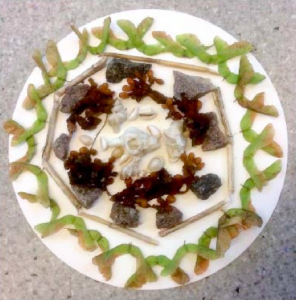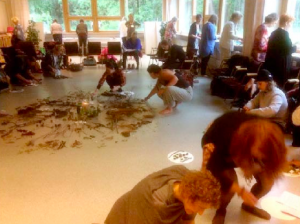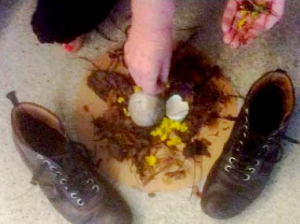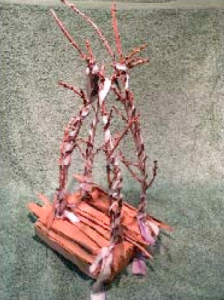By Ellen Speert, ATR-BC, REAT | October 27, 2016 | About Art Therapy
The Nez Pierce have a saying: “Heal yourself and heal Mother Earth and all our relations.” It is widely agreed that art therapy is as old as the earliest human expression. We cite prehistoric cave paintings as evidence that people used art (therapy) to relate to what was most important to their lives, utilizing available materials to summon power in relationship to their needs. Yet, eco- art therapy is seen as a new, even innovative, aspect of our field. Really? I think it has been only our recent development as a modern psychological field that has separated art therapy into a profession removed from the world of nature.

Nature materials can bring a sense of balance and grounding.
What is eco-art therapy?
Eco-art therapy expands our awareness and creative response to our clients beyond focus on the individual/family/group/culture to include larger ecological systems as the source of both suffering and healing (Gage & Speert, 1995). If we are to be a vital and cutting edge profession, we must no longer neglect our primal bond with nature and we must tap our ecological unconscious (Roszak, 1993).
Eco-art therapy’s roots take us back to the earliest human art making, through which people were intimately connected to their environments. It builds on the historic use of art as ritual, interaction, and relationship, and challenges the legacy of the solitary artist (Gablik, 1991). Indeed the art therapist, by moving into an ecological artistic context that celebrates collaboration and interconnection, can better serve their clients, their community and the world at large.
This expanded psychological perspective also utilizes an enriched array of art materials to deepen identification with the natural world (Biermann, 2013). Materials found in one’s local environment are not only sensorily rich and varied, they bring us into connection with seasonal cycles, regional plants and animals, and provide free media, thus removing a cost barrier in this age of tightening budgets.
Richard Louv (2005) coined the phrase “nature deficit disorder” as he studied children cut off from the experience of interaction with nature− becoming increasingly consumed with digital technology. Understanding the intricate living web of interdependent connections didn’t start with the internet. By making art in relation to the earth, we set the context for emotional and psychological health as it resides not just within the individual, the family, the community or even the human species, but in our relation to the entire planet. As Theodore Roszak (1993) writes, “Other therapies seek to heal the alienation between person and person, person and family, person and society. Ecopsychology seeks to heal the more fundamental alienation between the person and the natural environment.” (p. 48)

Participants connect with the natural world and materials in Helsinki.
Where is eco-art therapy practiced?
Even if your art therapy studio is on the third floor of a Manhattan skyscraper, in the basement of a San Diego office building, or in an abandoned factory in Munich, nature can be called into your sessions. (I have actually practiced eco-art therapy in all of these settings.) Of course, it is preferable to be surrounded by the dynamic colors, sounds, textures and smells of nature; to be able to take your shoes off and feel the temperature and texture of the earth. But do not let location be a barrier. You can bring the world into your office or studio.
Materials:

Art materials can be found all over and do not need to be expensive to be meaningful.
Art materials can turn up wherever you may be. I collect seashells on my beach walks, seedpods, branches, pinecones, leaves and bird feathers even on walks in the city. I have gathered them on the streets of Paris, London and Istanbul when giving workshops. I collect the petals of roses as they dry and the empty eggshells from meals. (Last month, when I was presenting an eco-art therapy workshop in Helsinki, the hotel restaurant was delighted to save eggshells for me). Mimi Farelly Hansen and I collected the scraps washed up after Hurricane Katrina to use in our eco-art therapy course at the AATA convention in New Orleans. Materials are everywhere.
The message to clients is that purchasing expensive materials is not a requirement for creating personally relevant art. All we need is the curiosity about how what is around us can be gathered and utilized to express our ideas and emotions. Eco-art therapy extends mindfulness to our movement through the world. We start noticing more and appreciating the variety of what we find. Our imagination is the only barrier to practicing this approach to art therapy and in gathering the rich array of media the earth provides. Caveat: when collecting nature materials, never take the last of anything, always leave some behind.
As Mary Oliver expresses in her poem “Prayer”:
It doesn’t have to be
the blue iris, it could be
weeds in a vacant lot, or a few
small stones; just
pay attention, then patch
a few words together and don’t try
to make them elaborate, this isn’t
a contest but the doorway
into thanks, and a silence in which
another voice may speak.
How to Begin:

Client gathered fruit tree prunings to create a soothing space for herself on top of a eucalyptus bench.
“What is your earliest memory of a connection to nature?” This is often the way I open an eco-art therapy workshop. Another valuable question for art therapists I teach: “How does your relationship to the earth inform your creative work?” Oliver Sacks spoke of his religion being nature. The challenge for us as art therapists is to value, indeed cherish, the place we find ourselves−for itself− and in doing so, to awaken in ourselves a sense of belonging and a sense of responsibility (Couts & Jokela, 2008). We do this by using materials and metaphors connected to the world of our clients and this is enhanced through sensitively collecting what resides there. We care for what we feel connected to and identify with.
Ideally we can take our clients to a place where they can:
1. Spend time in nature without distraction
2. Use all five senses
3. Utilize the stimulation of nature to reduce depression
4. Find the grounding of the earth to reduce anxiety
5. Feel the connection to the world of nature to reduce isolation and the short-sighted use of materials
But you can start right where you are. Look around. The earth is generous in providing all you need.
If you would like to see how eco-art therapy is practiced at my retreat center, please visit: www.artRETREATS.com. A video created by Ralph Chaney about the California Center for Creative Renewal and eco-art therapy work in the garden can be viewed here.
References
Biermann, H. (2013). The Stehekin kite project and the practice of eco-art therapy. Proceedings,
AATA 2013 National Conference.
Couts, G. & Jokela, T. (2008). Art, community and environment. Chicago, IL: Gutenberg
Press.
Berry,W.(2002). The art of the commonplace: The agrarian essays of Wendell Berry.
Emeryville, CA.
Gablik, S. (1991). The re-enchantment of art. New York: Thames and Hudson.
Gage, D. and Speert, E. (1995). Collaborating with artists: Individual and communal healing.
Proceedings, AATA 1995 National Conference.
Louv, R. (2005). Last child in the woods: Saving our children from nature-deficit disorder.
Algonquin Books.
Roszak, T. (1993). Awakening the ecological unconscious. Exploring our Interconnectedness,
34, 48-51.
